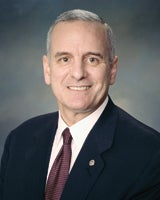Dayton faces different budget pressure
Published 9:56 am Monday, January 26, 2015
ST. PAUL — A $1 billion surplus sounds like plenty for Democratic Gov. Mark Dayton and state lawmakers to spread around for new education initiatives, tax cuts and road and bridge improvements.
But there’s no shortage of groups grabbing for a share of the projected surplus, which some finance experts think will grow when a new economic update is produced next month.
Dayton unveils his two-year proposal on Tuesday, setting the tone for a months-long debate over a $40 billion-plus budget. Glimpses he offered last week suggest he’ll earmark most of the surplus for education, expanded social services for struggling families and a targeted tax cut. It’s a world away from past Dayton budgets where spending reductions and tax hikes were his routes to patch recurring deficits.
Even so, there’s a fundamental divide between power brokers at the Capitol on whether to invest in initiatives that could pay dividends years later or return a substantial amount to Minnesota taxpayers now. Either way, the state’s extra cash will dry up fast.
“A billion dollars isn’t what it used to be. If you account for inflation of people’s salaries and benefits it’s pretty much all used up without even considering big new initiatives that are out there,” said Republican Rep. Jim Knoblach, chairman of the powerful House Ways and Means Committee. “There’s not as much money available for new initiatives as people might think there is.”
Aside from a separate transportation package he was to release today, Dayton has been clear he won’t seek increased taxes to pay for government programs this time.
He knows that hems in his ambitions. After outlining pieces of his budget at a conference on youth issues last week, Dayton noted $1 billion isn’t as big a surplus as it seems.
“At the end of the day, we’re not going to have enough resources for everything that needs to be done, for all the families and children we need to reach,” he said. “So we need to be talking about what more we can do. It’s not just about spending more money though that’s part of it.”
The top priorities of majority Senate Democrats are to fund all-day preschool statewide and cover tuition at two-year community colleges and technical schools. Both would cost plenty.
Advocates for rural Minnesota towns and counties are hoping to cash in on a sharp focus on Greater Minnesota at the Legislature thanks to the GOP’s election gains in outstate districts. Their wish list for roads and bridges, broadband Internet expansion, bigger local government aid payments, workforce training and housing clocks in above $1 billion.
The Coalition of Greater Minnesota Cities and the Greater Minnesota Partnership are calling for $800 million over the next two years split between repairs for rural roads and projects on interstate highways. Though that transportation plan may tap surplus funds, it could also draw from a bonding bill or transportation funding package.
Split government will temper those plans.
Knoblach said Republicans in control of the House are almost certain to devote a bigger share of the surplus than Dayton to tax relief. He said they could try to free up more money for those breaks and targeted investments like transportation by scaling back spending on some existing programs. But he said people should measure their appetites.
Still, Democratic Rep. Lyndon Carlson, a budget expert now in his 43rd legislative session, said governors usually come away with much of their marquee programs intact because they have the bully pulpit to help drive them. So for lawmakers and groups with a pet cause, getting into the governor’s budget proposal at the start makes a huge difference in an initiative’s fate.
“If the governor doesn’t include it in his budget, you’ve got a steep hill to climb,” Carlson said. “If a legislator or groups in the public advocate for something that’s not in his budget, then you’ve got to find the dollars.”
In all likelihood, the sides won’t come together on a complete budget until the session’s final days in mid-May.






